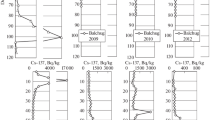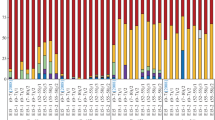Abstract
A stationary sorption model has been developed for re-evaluating and analysing archive data from 1950–1951 on the radioactive contamination of Techa river bottom sediments close to the site of liquid radioactive waste discharge. In general, good agreement was obtained between calculations and measurements, which substantiates further the assumptions and conclusions in two preceding articles, on the radionuclide composition of discharged liquid radioactive waste. Estimates on the effective liquid radioactive waste discharges given here are significantly different from those deduced in the 1950s, i.e. in summer 1950 and October 1951. The results are discussed in relation to the Techa River Dosimetry System 2000 (TRDS-2000) that has recently been presented to serve as a means for estimating doses to the Techa river residents. Parameter values describing the exponential decrease of bottom sediment contamination along the river due to short-lived radionuclides, such as 106Ru, and 144Ce, agree reasonably with those used in TRDS-2000. However, for other radionuclides, such as 95Zr, 95Nb, 91Y, 90Sr and 137Cs, substantial differences are found. It is demonstrated that water flow rate, width of the river, and surface area of bottom sediments are important parameters which were not adequately taken into account in TRDS-2000. Also, the stirring-up of contaminated bottom sediments and their subsequent transport by the water flow are seen to be an important mechanism that governs the radionuclide transport downstream. This mechanism was not included in the TRDS-2000 model. It is concluded that the sorption model used in TRDS-2000 for the reconstruction of radioactive contamination of water and bottom sediments of the Techa river in 1949–1951, is subject to considerable errors. While the present paper is focussed on details of the dosimetric modelling, the implications for the Techa river dosimetry are major. They will be further elucidated in a forthcoming paper.



Similar content being viewed by others
Notes
In contrast to current usage, activities in this article are specified in the former unit Ci (=3.7×1010 Bq). This is done in order to simplify the reference to historical records and also to facilitate comparison with those related Russian publications which still employ the former unit.
References
Ilyin DI (1956) Migration of radioactive substances from open reservoirs (in Russian). Doctoral thesis, Technical Sciences, Mayak PA archives, Ozyorsk
Mokrov YG (2003) Reconstruction of the radionuclide spectrum of liquid radioactive waste released into the Techa river in 1949–1951. Radiat Environ Biophys 42:7–15
Mokrov YG (2002) Reconstruction and prediction of radioactive contamination of the Techa river. Part I. Role of weighted particles in forming of the Techa river radioactive contamination during 1949–1951 (in Russian). Library of the journal “Issues on Radiation Safety” No. 1, Ozyorsk
Guessev NG, Rubtsov PM, Kovalenko VV, Kolobashkin VM (1974) Radiation characteristics of the fission products. Reference book (in Russian). Atomizdat
Mayak Production Association (1950) Decontamination of low-active solutions from toxic radioactive elements and hexavalent chrome and discharge of decontaminated solutions: Report. Mayak PA archives, Ozyorsk
Hydrometeorology Committee (1988) Prediction technique of reservoir contamination status in operational deviations at NPP: methodic recommendations. Report RD 52.26174–88 (in Russian). USSR State Hydrometeorology Committee, Moscwa
WMO (1981) Guide to hydrological practices. World Meteorological Organization 168, Vols. 1 and 2
Mokrov YG (2003) Radioactive contamination in the upper reaches of the Techa river: stirring-up of bottom sediments and precipitation of suspended particles. Analysis of the data obtained in 1949–1951. Radiat Environ Biophys (in press)
Mokrov YG (2002) Bottom sediment process of stirring-up and suspension precipitation in the upper part of the Techa river in 1949–1951 (in Russian). Issues on Radiation Safety 4:22–34
Vorobiova MI, Degteva MO (1999) Simple model for the reconstruction of radionuclide concentrations and radiation exposures along the Techa River. Health Phys 77:142–149
Author information
Authors and Affiliations
Corresponding author
Appendix
Appendix
Assume that at the location x=0 of the river there is a stationary (i.e. time-constant) LRW discharge of activity into the river system. The activity is subsequently distributed between water and bottom sediments of the river, the remaining activity being transported downstream with the flow. After a certain time the river system will, along its entire length, reach a stationary distribution of specific activity in exchange layer of the bottom sediments, i.e. in the layer that is involved in the sorption/desorption processes. Given this stationary pattern in the sediment surface, the rate of radioactive decay of any of the radionuclides will be proportional to the rate of change of the activity flow D(x), i.e. the activity transported by the river through the position x per unit time.
Consider a differential volume element in the exchange layer of the bottom sediments:
where w is the width of the river (taken to be constant along its entire length), h is the thickness of the exchange layer of the bottom sediments, and dx is the extension of the considered volume element in the direction of the river flow. The change of the activity due to radioactive decay in the considered diffential volume element of the bottom sediment can then be represented as follows:
where λ is a decay constant, А(х) is the specific activity of bottom sediments in the river section (activity per dry weight) and ρ is the density (dry weight per total volume of wet sediments) of the bottom sediment exchange layer.
Assume that the activity per unit volume in the river water, С(х), is in dynamic equilibrium with the activity in the exchange layer of the bottom sediment in any river section. The change of the radioactive outflow D(x) from the elementary section can be expressed as follows:
where Q is the water outflow rate (taken to be constant along the entire length of the river), К d is the distribution coefficient for the radionuclide of interest in the “water-bottom sediment” system (scaled to dry weight).
The activity balance in the system that is being considered is expressed by the following equation:
with the constant:
The solution of this equation is:
where А 0 is the specific activity of the bottom sediments at the LRW discharge site (х=0).
Rights and permissions
About this article
Cite this article
Mokrov, Y.G. Radioactive contamination of bottom sediments in the upper reaches of the Techa river: analysis of the data obtained in 1950 and 1951. Radiat Environ Biophys 42, 155–168 (2003). https://doi.org/10.1007/s00411-003-0211-x
Received:
Accepted:
Published:
Issue Date:
DOI: https://doi.org/10.1007/s00411-003-0211-x




